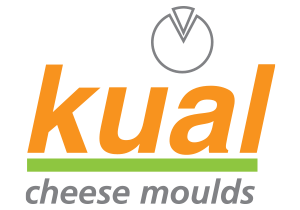свойства
NUESTRO PRODUCTO
PRODUCT: THERE IS NO CHEESE WITHOUT A MOULD
Cheese is a misshapened fluid before been pressed; that is why the mould is essential to drain and to shape the product
Desde los antiguos moldes de madera, los materiales y las máquinas para lograrlos fueron cambiando. Antes había quesos que necesitaban hasta 8 horas de prensado, ahora este tiempo se reduce hasta lograr entre 35 y 90 minutos un queso terminado. En miras de procesos más rápidos se han utilizado adelantos técnicos que no perdieran de vista la calidad del producto final.
El molde de Kual responde así a las necesidades de la industria quesera.
BENEFITS OF A MICRO-PERFORATED PLASTIC MOULD
- Plastic materials have highest hygiene standards. Cloth is not longer needed for the draining and that avoids long cleaning processes with great amounts of water and special products to take out the sticky substance from the fabric.
- Plastic avoids creasing of the cloth that ends marking the cheese. It is not necessary to turn around during the pressing period. The cheese fills perfectly the shape of the mould so there is no waste of the fluid.
- Acidification process is faster and pressing more effective.
- The pressing process is shortened and the production time improves.
- Section: Increases the contact surface and facilitates the whey draining. The pattern will be design depending on the product. This pattern defines the texture characteristics; the section will be thinner if the intention is to make it less visible. The result is a cheese with a neat pattern that gives the idea of the cloth without markings.
MICRO-PERFORATIONS
The quantity of micro perforations by mm and degree is decided according with the cheese humidity.
A robotized system is use to drill micro-perforations with specific angle inclination in the mould in order to make it more efficient. This system avoids the break in the chemical chain of the material and it prevents the obstruction of the micro-perforations.
Diameters from 0.2 to 0.9 mm can be drill to meet the client requirements, depending on the type of cheese that will be produced.
Moulds assembling and pattern are handmade, according to the client specifications.
MATERIAL
We use high molecular weight polyethylene and polypropylene; suitable material for food contact, meet FDA certification and complying with CODEX (European Union) rules.
The thickness of our moulds gives them strength and lengthen their useful life.
Ethylene, that provides elasticity to the plastic normally has a tendency to vaporize with the crystallization of the molecules. Thicker edges avoid the early lost of elasticity and the moulds have longer use.
A small dose of special products is needed to wash thoroughly our moulds.
MOULDING AND PRESSING
Nowadays, the most traditionally used moulds are those made of plastic or stainless steel, which need cloth to wrap the cheese.
The problem is that for the pressing work with this mould system, a lot of handling is required and, thus, a lot of labour, because normally the process entails the following:
- Cheese dressing and pouring into moulds.
- Putting mould in the press.
This post is also available in:
Испанский Английский Французский Португальский, Бразилия
